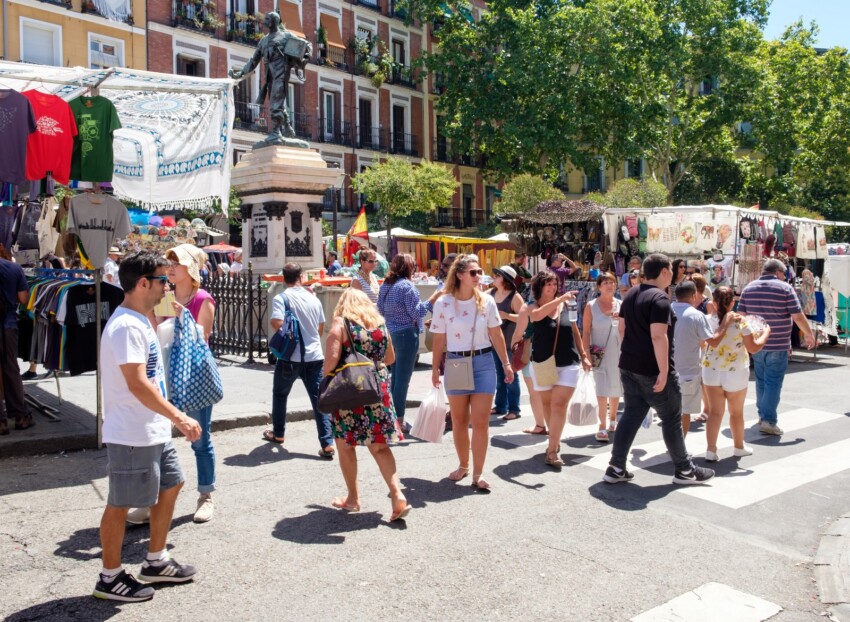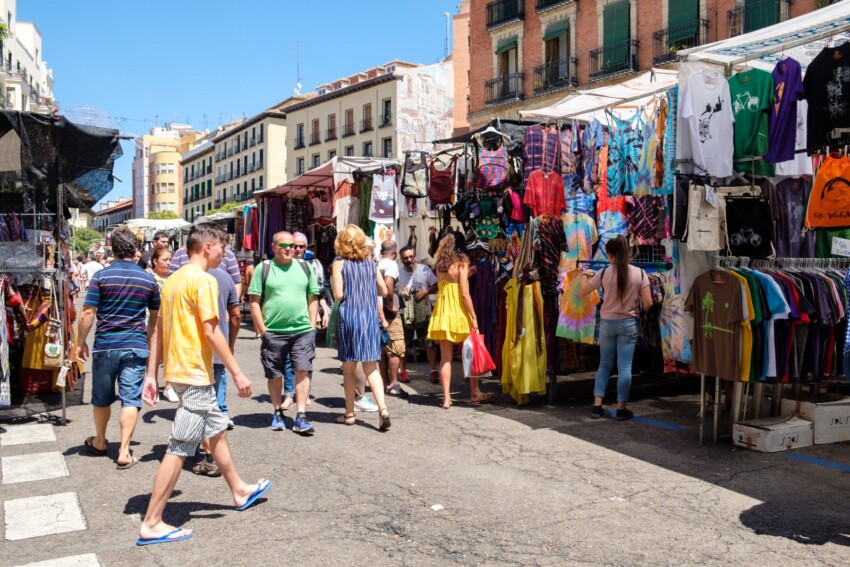

An unmissable Sunday event in Madrid is the Rastro Market, the largest open-air market in the Spanish capital.
Beloved by the Madrileños, this ancient market, whose foundation dates back to the 15th century, has risked closure several times but has resisted and even expanded in spite of the restrictions imposed by the municipal administration, which has tried on several occasions to regulate the market.
It has expanded by leaps and bounds, in an entirely irregular manner, and today counts an indefinite number of stalls, probably more than a thousand, where you can buy really anything.
If you find yourself in Madrid at the weekend, don’t miss the chance to immerse yourself in the lively atmosphere of this gigantic market. Get lost in the crowds and let yourself be stunned by the bright colours of the merchandise on sale and the hubbub of sellers and buyers.
You can test your bargaining skills – negotiating prices is common practice – and end your day with tapas and cerveza in a typical local bar.
The Rastro Market is known as Madrid’s flea market , but today the merchandise for sale is no longer limited to second-hand goods.
You can still find many stalls selling used furniture, clothes, records and books, as well as various knick-knacks and valuable antiques, but these have been joined by stalls selling new clothes, accessories, fruit and vegetables, electrical equipment, souvenirs and all sorts of objects, useful and useless.
Space is also given to handicrafts and art: an entire street is dedicated to the sale of paintings and painting materials.

The Rastro market takes place every Sunday and public holidays from 9 a.m. to 3 p.m. in the popular neighbourhood of La Latina, one of the historical areas in the centre of Madrid.
The nerve centre of the market is the Plaza de Cascorro, while among the streets that are occupied by the vendors’ stalls we can safely name Toledo, Embajadores, Ronda de Toledo, San Cayetano, Fray Ceferino González, Carlos Arniches, Mira el Río, Calle Ribera de Curtidores, Rodas and the squares General Vara del Rey and de Campillo del Mundo Nuevo.
However, it is impossible to draw up a precise list of the streets concerned because the Rastro Market occupies a very extensive area with unclear boundaries and is constantly evolving.
If you want to travel by metro, you can get off at three different stops near the Rastro market: Tirso de Molina (L1), Embajadores (L3) and Latina y Puerta de Toledo (L5); alternatively, you can get there by bus or regional train (Embajadores station).
The Rastro market is located in Plaza de Cascorro. In this small square, little more than a cross between two streets, you’ll find no less than 6 accommodations, making it easy to find a place to sleep near this interesting Madrid attraction. Also within walking distance is the La Latina neighbourhood, with its convenient metro stop, while another smart alternative could be to sleep in the Plaza de Tirso de Molina area, a small green lung with an adjacent metro stop.
The ‘rastro’ that gives the market its name is the trail of blood left on the ground by animals killed in neighbourhood slaughterhouses that no longer function.
The Rastro Market is mentioned in many works of Spanish literature: authors who paid homage to the popular market in their works include Cervantes, Covarrubias, Armesto y Casto.
Unfortunately, pickpockets are not in short supply in Madrid and the markets provide an excellent opportunity for them to steal without being seen.
During your visit to the Rastro market, or any other market in Madrid, keep your bag tightly closed and clutched to you, only talk to stall owners and do not listen to people who approach you offering you fabulous bargains. Also be careful with valuables.
Little tricks and a little care are enough to avoid ruining your holiday!
The Rastro market is located in Plaza de Cascorro, in the neighbourhood of La Latina, a few kilometres south of the city centre not far from the Museo de San Isidro.
City Card allow you to save on public transport and / or on the entrances to the main tourist attractions.
